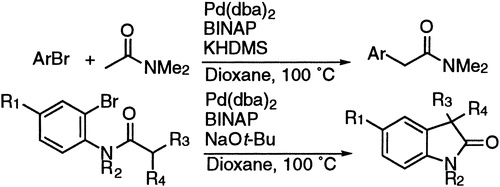Palladium-catalyzed inter- and intramolecular alpha-arylation of amides. Application of intramolecular amide arylation to the synthesis of oxindoles
J. Org. Chem., 1998, 63 (6546-6553)
View on publisher site
Abstract
2A palladium-catalyzed α-arylation of amides is reported. Intermolecular arylation of N,N-dimethylamides and lactams occurs using aryl halides, silylamide base, and a palladium catalyst. Intramolecular arylation of N-(2-halophenyl)amides occurs using alkoxide base and a palladium catalyst. The palladium catalyst was formed in situ from Pd(dba)2 (dba = trans,trans-dibenzylidene acetone) and BINAP (2,2‘-bis(diphenylphosphino)-1,1‘-binaphthalene). Although the intermolecular arylation of amides is less general than that reported previously for ketones, unfunctionalized and electron-rich aryl halides gave α-arylamides in 48−75% yield and N-methyl-α-phenylpyrrolidinone in 49% yield. These reactions provided the highest yields yet reported for regioselective amide arylations. Intramolecular amide arylation of 2-bromoanilides gave oxindoles in 52−82% yield. Mono- and disubstituted acetanilides gave 1,3-di- and 1,3,3-trisubstituted oxindoles. The use of dioxane, rather than THF, solvent was important for some of the amide arylations.
Read on publisher's site